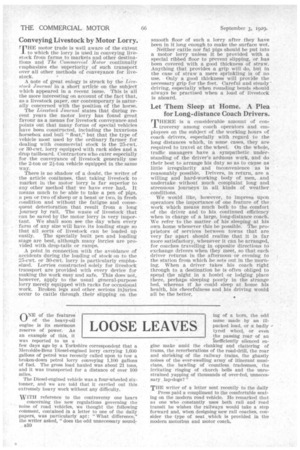Conveying Livestock by Motor Lorry.
Page 44

If you've noticed an error in this article please click here to report it so we can fix it.
111HE motor trade is well aware of the extent 1 to which the lorry is used in conveying livestock from farms to markets and other destinations and The Commercial Motor continually emphasizes (he superiority of such transport over all other methods of conveyance for live
stock. •
A note of great eulogy is struck by the Livestock Journal in a short artkle on the subject which appeared in a recent issue. This is all the more interesting on account of the fact that, as a livestock paper, our contemporary is naturally concerned with the position of the horse.
The Livestock Journal states that during recent years the motor lorry has found great favour as a means for livestock conveyance and points out that many forms of special vehicles have been constructed, including the luxurious horsebox and bull "float," but that the type of vehicle most used by the ordinary farmer for dealing with commercial stock is the 25-cwt. Or 30-cwt. lorry equipped with rack sides and a drop tailboard. Contractors who cater especially for the conveyance of livestock generally use the 2-ton or 2i-ton vehicle equipped in the same way.
• There is no shadow of a doubt, the writer of the article continues, that taking livestock to market in the motor lorry is far superior to any other method that we have ever had. It means much to be able to take a pen of pigs, a pen or two of sheep or a beast or two, in fresh condition and without the fatigue and consequent deterioration that result from a long journey by rail. The waste of livestock • that can be saved by the motor lorry is very important. We shall soon 'see the clay when every farm of any size will have. its loading stage so that all sorts of livestock can be loaded up easily. The specially built pen and loading stage are hest, although many lorries are provided with drop-tails or ramps.
A point in connection with the avoidance of accidents during the loading of stock on to the 25-cwt. or 30-cwt. lorry is particularly emphasized. Lorries constructed solely for livestock transport are provided with every device for making the work easy and safe. This does not, however, apply to the usual general-purpose lorry merely equipped With racks for occasional work. Broken legs and other serious injuries 'occur to cattle through their slipping on the smoOth floor of such a lorry after they have been in it long enough to make the surface wet.
Neither cattle nor fat pigs should be put into a motor lorry unless it be provided with a special ribbed floor to prevent slipping, or has been covered with a good thickness of straw. Anything that provides a grip will do, but in the case of straw a mere sprinkling is of no use. Only a good thickness will provide the necessary grip for the feet. Careful and steady ' driving, especially when rounding bends should always be practised when a load of livestock is aboard.
Let Them Steep at Home. A Plea for Long-distance Coach Drivers.
TEHE is a considerable amount of controversy among coach operators and employees on the subject of the working hours of coach drivers, especially with regard to the long distances which, In some cases, they are required to travel at the wheel. On the whole, traffic managers have a sympathetic understanding of the driver's arduous work, and do their best to arrange his duty so as to cause as little irregularity and inconvenience as is reasonably possible. Drivers, in return, are a willing and hard-working body of men, and undertake without much complaint long and strenuous journeys in all kinds of weather conditions.
We -would like, however, to impress upon operators the importance of one feature of the. work which means much both to the comfort of the driver and to his continued efficiency when in charge of a large, long-distance coach. We refer to the matter of his sleeping at his own home whenever this be possible. The proprietors of services between towns that are very far apart should realize that it is far more satisfactory, whenever it can he arranged, for coaches travelling in opposite directions to exchange drivers when they meet, so that each driver returns in the afternoon or evening to the station from which he sets out in the mornInc,. When a driver takes his coach right through to a destination he is often obliged to spend: the night in a hostel or lodging, place there, Perhaps sleeping poorly in the strange bed, whereas if he could sleep at home his health, his cheerfulness and his driving would
all be the better. •




















































































































